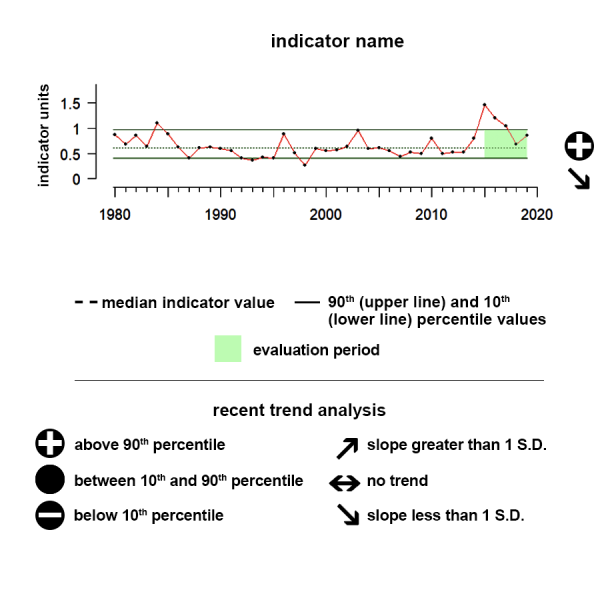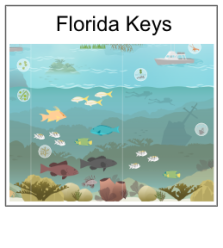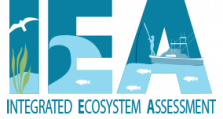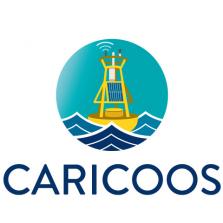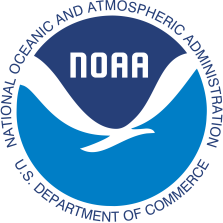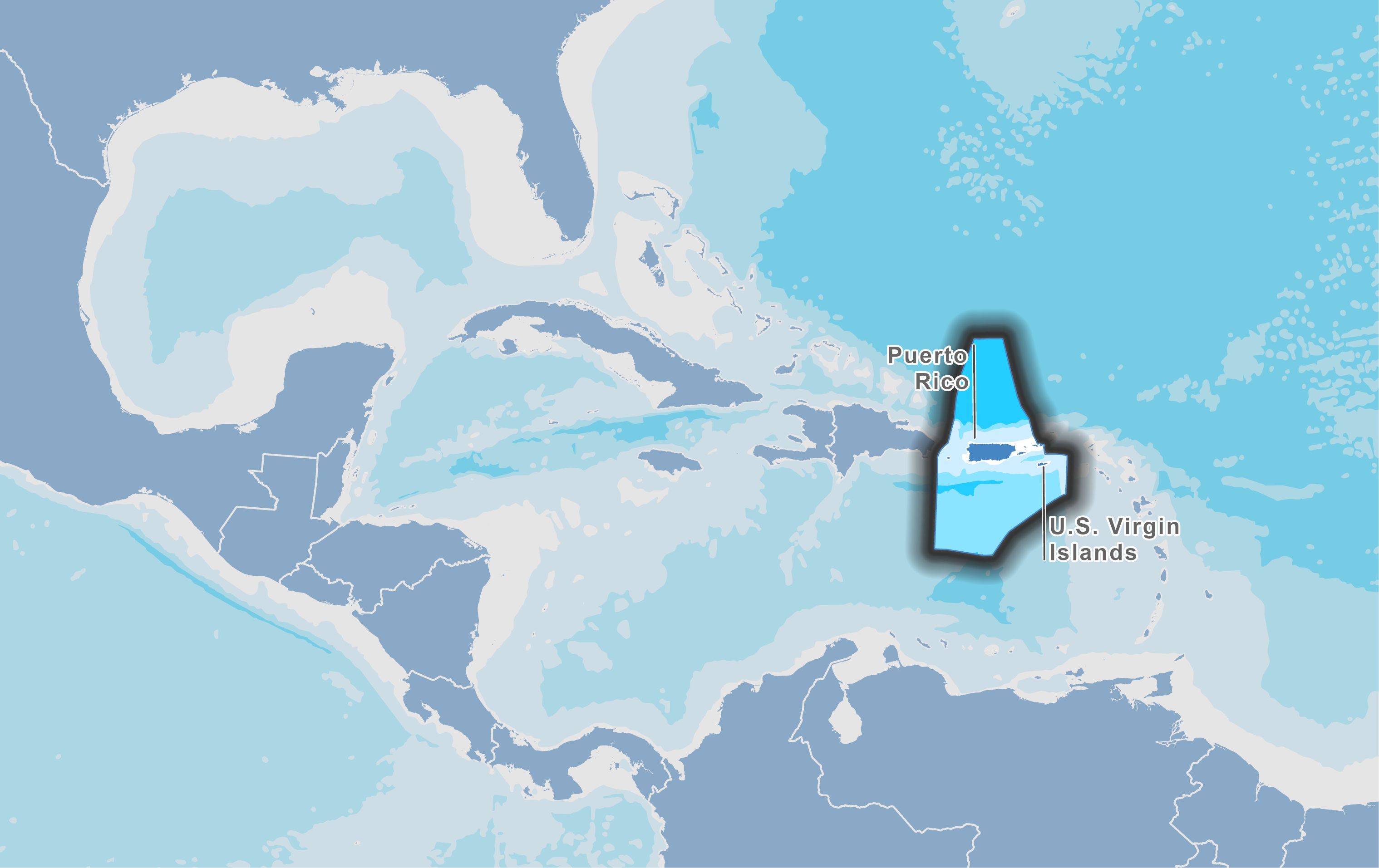
The Caribbean region is renowned for its diverse marine life, rich mixing of cultures, turquoise waters and spectacular beaches. The U.S. portion of this region (Puerto Rico and the U.S. Virgin Island) is home to some important coral reef ecosystems. As one of the most biologically rich marine environments in the Atlantic, the Caribbean is home to 10% of the world's coral reefs, 1,400 species of fish and marine mammals, and extensive coastal mangroves. The clean beaches, vibrant coral reef systems, exotic marine life, and abundant seafood support tourism and a source of food for people in the region.
Understanding the Time series plots
Time series plots show the changes in each indicator as a function of time, over the period 1980-present. Each plot also shows horizontal lines that indicate the median (middle) value of that indicator, as well as the 10th and 90th percentiles, each calculated for the entire period of measurement. Time series plots were only developed for datasets with at least 10 years of data. Two symbols located to the right of each plot describe how recent values of an indicator compare against the overall series. A black circle indicates whether the indicator values over the last five years are on average above the series 90th percentile (plus sign), below the 10th percentile (minus sign), or between those two values (solid circle). Beneath that an arrow reflects the trend of the indicator over the last five years; an increase or decrease greater than one standard deviation is reflected in upward or downward arrows respectively, while a change of less than one standard deviation is recorded by a left-right arrow.
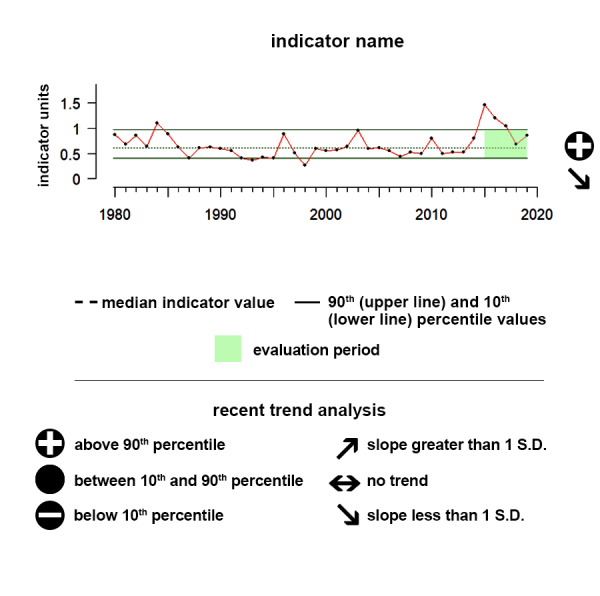
North Atlantic Oscillation (NAO)
During the last five years, the NAO indicator shows no significant trend but has remained largely in the negative phase.
Values correspond to Index scores
Description of time series:
Positive NAO values mean significantly warmer winters over much of the eastern U.S. and northern Europe and negative NAO values can mean cold winter outbreaks and heavy snowstorms. During the last five years, the NAO indicator shows no significant trend but has remained largely in the negative phase.
Description of North Atlantic Oscillation (NAO):
The North Atlantic Oscillation (NAO) Index measures the relative strengths and positions of a permanent low-pressure system over Iceland (the Icelandic Low) and a permanent high-pressure system over the Azores (the Azores High). When the index is positive (NAO+) significantly warmer winters can occur over much of the eastern U.S. This prevents nutrient-rich upwelling, which reduces productivity. When the NAO index is negative, the upper central and eastern portions of the United States can incur winter cold outbreaks and heavy snowstorms. This climate condition impacts people and ecosystems across the globe and each of the indicators presented here. Interactions between the ocean and atmosphere alter weather around the world and can result in severe storms or mild weather, drought, or flooding. Beyond “just” influencing the weather and ocean conditions, these changes can produce secondary results that influence food supplies and prices, forest fires and flooding, and create additional economic and political consequences.
Data:
Climate indicator data was accessed from the NOAA NCEI (https://www.NCEI.noaa.gov/teleconnections/nao). The data plotted are unitless anomalies and averaged across a given region.
Atlantic Multidecadal Oscillation
During the last five years, the AMO has largely been in a positive phase, and continues to trend upward.
Values correspond to Index scores
Description of time series:
Positive AMO values indicate the warm phase, during which surface waters in the North Atlantic Ocean are warmer than average, and negative AMO values indicate the cold phase, during which surface waters in the North Atlantic Ocean are cooler than average. During the last five years, the AMO has largely been in a positive phase, and continues to trend upward.
Description of Atlantic Multidecadal Oscillation (AMO):
The Atlantic Multidecadal Oscillation is a series of long-duration changes in the North Atlantic sea surface temperature, with cool and warm phases that may last for 20-40 years. Most of the Atlantic between the equator and Greenland changes in unison. Some areas of the North Pacific also seem to be affected. This broadscale climate condition affects air temperatures and rainfall over much of the Northern Hemisphere. It is also related to major droughts in the Midwest and the Southwest of the U.S. In the warm phase, these droughts tend to be more frequent and/or severe. Vice-versa for the cold phase. During the warm phases the number of tropical storms that mature into severe hurricanes is much greater than during cool phases. Despite the association of AMO with multiple weather and climate impacts, recent scientific debate has questioned whether this indicator is a natural climate variation, like the other climate indicators presented here, or a response of the climate system to human-caused climate change. Whether natural or a result of human-caused climate change, AMO is a useful feature for tracking large-scale weather and climate events. This climate condition impacts people and ecosystems across the globe and each of the indicators presented here. Interactions between the ocean and atmosphere alter weather around the world and can result in severe storms or mild weather, drought, or flooding. Beyond “just” influencing the weather and ocean conditions, these changes can produce secondary results that influence food supplies and prices, forest fires and flooding, and create additional economic and political consequences
Data Background:
Climate indicator data was accessed from NOAA’s Earth Systems Research Laboratory (https://www.esrl.noaa.gov/psd/data/timeseries/AMO/). The data plotted are unitless anomalies and averaged across a given region
US Caribbean SST
During the last five years there has been no notable trend and values were between the 10th and 90th percentiles of all observed data in the time series.
Sea surface temperature is defined as the average temperature of the top few millimeters of the ocean. Sea surface temperature monitoring tells us how the ocean and atmosphere interact, as well as providing fundamental data on the global climate system
Data Interpretation:
Time series: The time series shows the integrated sea surface temperature for the Caribbean region. During the last five years there has been no notable trend and values were between the 10th and 90th percentiles of all observed data in the time series.
Indicator and source information:
The SST product used for this analysis is the NOAA Coral Reef Watch CoralTemp v3.1 SST composited monthly (https://coralreefwatch.noaa.gov/product/5km/index_5km_sst.php) accessed from CoastWatch (https://oceanwatch.pifsc.noaa.gov/erddap/griddap/CRW_sst_v3_1_monthly.g…).
Great Lakes SST data were accessed from (https://coastwatch.glerl.noaa.gov/glsea/glsea.html).
The data are plotted in degrees Celsius.
Data background and limitations:
The NOAA Coral Reef Watch (CRW) daily global 5km Sea Surface Temperature (SST) product, also known as CoralTemp, shows the nighttime ocean temperature measured at the surface. The CoralTemp SST data product was developed from two, related reanalysis (reprocessed) SST products and a near real-time SST product. Monthly composites were used for this analysis.
US Caribbean Sea Level
During the last five years, there has been no trend and values between the 10th and 90th percentiles of all data.
Sea level varies due to the force of gravity, the Earth’s rotation and irregular features on the ocean floor. Other forces affecting sea levels include temperature, wind, ocean currents, tides, and other similar processes.
Description of time series:
The time series shows the relative sea level for this region. During the last five years, there has been no trend and values between the 10th and 90th percentiles of all data.
Indicator and source information:
NOAA monitors sea levels using tide stations and satellite laser altimeters. Tide stations around the globe tell us what is happening at local levels, while satellite measurements provide us with the average height of the entire ocean. Taken together, data from these sources are fed into models that tell us how our ocean sea levels are changing over time. For this site, data from tide stations around the US were combined to create regionally averaged records of sea-level change since 1980. We present data for all regions.
Data background and limitations:
Sea level data presented here are measurements of relative sea level, water height as compared to nearby land level, from NOAA tide gauges that have >20 years of hourly data served through NOAA’s Center for Operational Oceanographic Products and Services (CO-OPS) Tides and Currents website. These local measurements are regionally averaged by taking the median value of all the qualifying stations within a region. The measurements are in meters and are relative to the year 2000.
Caribbean Heatwave Intensity
During the last five years there has been a significant increasing trend and the five-year average is above the 90th percentile of all observed data in the time series.
Values indicate cumulative annual heatwave intensity and duration in a region in degree-days
Description of Time Series: This time series shows the average integrated degree day value for the Caribbean region. During the last five years there has been a significant increasing trend and the five-year average is above the 90th percentile of all observed data in the time series.
Indicator Source Information:
The marine heatwave data shown here are calculated by NOAA’s National Centers for Environmental Information using Optimum Interpolation Sea Surface Temperature (OISST) data. The NOAA 1/4° OISST is a long term Climate Data Record that incorporates observations from different platforms (satellites, ships, buoys and Argo floats) into a regular global grid. The dataset is interpolated to fill gaps on the grid and create a spatially complete map of sea surface temperature. Satellite and ship observations are referenced to buoys to compensate for platform differences and sensor biases.
Data Background and Caveats:
Heatwave metrics are calculated using OISST, a product that uses some forms of interpolation to fill data gaps. Heatwaves are defined by Hobday et al., 2016 as distinct events where SST anomaly reaches the 90th percentile in a pixel for at least 5 days, separated out by 3 or more days.
Caribbean Heatwave Area
During the last five years there has been a significant decreasing trend and the five-year average is between the 10th and 90th percentiles of all observed data in the time series.
Values indicate monthly percent of an LME area affected by heatwave
Description of Time Series:
This time series shows the monthly heatwave spatial coverage for the Caribbean Region. During the last five years there has been a significant decreasing trend and the five-year average is between the 10th and 90th percentiles of all observed data in the time series.
Indicator Source Information:
The marine heatwave data shown here are calculated by NOAA’s National Centers for Environmental Information using Optimum Interpolation Sea Surface Temperature (OISST) data. The NOAA 1/4° OISST is a long term Climate Data Record that incorporates observations from different platforms (satellites, ships, buoys and Argo floats) into a regular global grid. The dataset is interpolated to fill gaps on the grid and create a spatially complete map of sea surface temperature. Satellite and ship observations are referenced to buoys to compensate for platform differences and sensor biases.
Data Background and Caveats:
Heatwave metrics are calculated using OISST, a product that uses some forms of interpolation to fill data gaps. Heatwaves are defined by Hobday et al., 2016 as distinct events where SST anomaly reaches the 90th percentile in a pixel for at least 5 days, separated out by 3 or more days.
Caribbean pCO2
Between 2019 and 2024 pCO2 showed an increasing trend but was mostly within the range of historical values.
The pCO2 data shown here as an ecosystem indicator of ocean acidification represent regional monthly averages of these mapped estimates.
Description of Time Series: Between 2019 and 2024 pCO2 showed an increasing trend but was mostly within the range of historical values.
Description of Sea Surface pCO2:
Carbon dioxide (CO2) released from fossil fuel burning and other human activities (also known as “anthropogenic CO2”) not only accumulates in Earth’s atmosphere, but is also absorbed by seawater at the ocean surface. This process represents a double-edged sword for the planet: CO2, which has negative consequences for climate change, is removed from the atmosphere but it also contributes to the acidification of ocean waters, which can harm sea life like corals and crabs. The partial pressure of CO2 in seawater (pCO2) represents the relative amount of CO2 in the water. It is a critical metric for calculating the exchange of CO2 across the air–sea interface and for tracking the effects of anthropogenic carbon on surface ocean chemistry.
Data Source:
Global observations of pCO2 from automated shipboard systems that take in and analyze water while a vessel is moving are aggregated in the Surface Ocean CO2 Atlas (SOCAT; Bakker et al., 2016). These shipboard observations have been combined with data from available observational, model-based, and satellite products (e.g., sea-surface temperature, salinity, and wind speed) to create estimates of surface ocean pCO2 in U.S. Large Marine Ecosystems over multiple decades, using a technique known as machine learning (Sharp et al., 2024). The pCO2 data shown here as an ecosystem indicator of ocean acidification represent regional annual averages of these mapped estimates. Uncertainty in pCO2 is estimated from a data-based validation of the machine-learning algorithms for each Large Marine Ecosystem, scaled by the data coverage in a given month. The complete dataset is available at https://www.ncei.noaa.gov/data/oceans/ncei/ocads/metadata/0287551.html.
Close
Caribbean pH
Between 2019 and 2024 pH showed no significant trend and was similar to historical values.
The pH data shown here as an ecosystem indicator of ocean acidification represent regional monthly averages of these estimates.
Description of Time Series: Between 2019 and 2024 pH showed no significant trend and was similar to historical values.
Description of Sea Surface pH:
Man-made (or “anthropogenic”) CO2 that is taken up by the ocean influences the chemistry of seawater, resulting in an increase in hydrogen ion concentration of the surface ocean (i.e. a decrease in surface ocean pH). pH can be viewed as a “master variable” in ocean chemistry, controlling acid-base balance in the sea. It is also a common way to quantify ocean acidification: average surface ocean pH has decreased by more than 0.1 units since the beginning of the industrial revolution (Jiang et al., 2023).
Data Source:
Mapped estimates of surface-ocean pCO2 in U.S. Large Marine Ecosystems (LME’s) (Sharp et al., 2024), based on observations from the SOCAT database, have been paired with another key ocean-carbon variable called total alkalinity (TA), estimated from salinity, temperature, and spatial information using algorithms called ESPERs (Carter et al., 2021), to calculate surface ocean pH across the U.S. LME’s. The pH data shown here as an ecosystem indicator of ocean acidification represent regional annual averages of these estimates. Uncertainty in pH is determined by propagating pCO2 and TA uncertainties through calculations, using reasonable estimates of uncertainty in required chemical constants and ancillary variables. The complete dataset is available at https://www.ncei.noaa.gov/data/oceans/ncei/ocads/metadata/0287551.html.
Close
Caribbean Aragonite
Between 2019 and 2024 Sea Surface Ωar showed a significant decreasing trend but was mostly within the range of historical values.
The Ωar data shown here as an ecosystem indicator of ocean acidification represent regional averages of these estimates.
Description of Time Series: Between 2019 and 2024 Sea Surface Ωar showed a significant decreasing trend but was mostly within the range of historical values.
Description of Sea Surface Ωar:
Many marine animals and plants build shells or other hard parts from the minerals aragonite and calcite, which are forms of the chemical compound calcium carbonate. The chemical building blocks of these minerals are calcium and carbonate ions, which are common constituents of seawater. However, one effect of ocean acidification is to reduce the carbonate ion concentration in seawater, making it more difficult for these minerals to form. The chemical expression that describes the tendency of these minerals to form at equilibrium is called the saturation state of that mineral: higher values support mineral formation, while lower values inhibit mineral formation, or even promote the dissolution of these minerals. We present here saturation-state estimates for the mineral aragonite (Ωar), which is used by many marine organisms including corals, mollusks, and some zooplankton to create hard parts. At 20°C, saturation state of the mineral calcite is about 50% higher than aragonite (Mucci, 1983)
Data Source:
Mapped estimates of surface-ocean pCO2 in U.S. Large Marine Ecosystems (LME’s) (Sharp et al., 2024), based on observations from the SOCAT database, have been paired with another key ocean-carbon variable called total alkalinity (TA), estimated from salinity, temperature, and spatial information using algorithms called ESPERs (Carter et al., 2021), to calculate surface-ocean Ωar across the U.S. LME’s. The Ωar data shown here as an ecosystem indicator of ocean acidification represent regional averages of these estimates. Uncertainty in Ωar is determined by propagating pCO2 and TA uncertainties through calculations, using reasonable estimates of uncertainty in required chemical constants and ancillary variables. The complete dataset is available at https://www.ncei.noaa.gov/data/oceans/ncei/ocads/metadata/0287551.html.
US Caribbean Chlorophyll-a
During the last five years there has been no significant trend and values have remained within the 10th and 90th percentiles of all observed data in the time series.
Chlorophyll a, a pigment produced by phytoplankton, can be measured to determine the amount of phytoplankton present in water bodies. From a human perspective, high values of chlorophyll a can be good (abundance of nutritious diatoms as food for fish) or bad (Harmful Algal Blooms that may cause respiratory distress for people), based on the associated phytoplankton species.
Data Interpretation:
Time series: This time series shows the average concentration levels of chlorophyll a for the Caribbean region. During the last five years there has been no significant trend and values have remained within the 10th and 90th percentiles of all observed data in the time series.
Indicator and source information:
Chlorophyll-a concentration values for this indicator were obtained using data from the European Spatial Agency (ESA) that is a validated, error-characterized, Essential Climate Variable (ECV) and climate data record (CDR) from satellite observations specifically developed for climate studies. The dataset (v56.0) is created by bandshifting the reflectances values from SeaWiFS, MODIS and VIIRS to MERIS wavebands if necessary, and SeaWiFS and MODIS were corrected for inter-sensor bias when compared with MERIS in the 2003-2007 period. VIIRS and OLCI were also corrected to MERIS levels, via a two-stage process comparing against the MODIS-corrected-to-MERIS-levels (2012-2013 for VIIRS and 2016-2019 for OLCI).
Source: https://climate.esa.int/en/projects/ocean-colour/key-documents/
https://docs.pml.space/share/s/fzNSPb4aQaSDvO7xBNOCIw
Annual means for each LME were calculated from the average of the 12 monthly means in that year on a pixel by pixel basis. Then for each year, the median average was taken spatially to yield one value per year per LME. The overall “National Annual Mean” mean was calculated as the average of all LME annual means. See the Data Background section for more details.
Data background and limitations:
Satellite chlorophyll a data was extracted for each LME from the ESA OC-CCI v6.0 product. These 4 km mapped, monthly composited data were - averaged over each year to produce pixel by pixel annual composites, then the spatial median was calculated for each LME, resulting in one value per year per LME. This technique was used for each LME from North America and Hawaii. The overall “National Annual Mean” was calculated as the average of all the LME annual means. Phytoplankton concentrations are highly variable (spatially and temporally), largely driven by changing oceanographic conditions and seasonal variability.
Coral Reefs - Puerto Rico
The Puerto Rico coral reefs scored 70, meaning some indicators meet reference values.

Data Interpretation:
The scores you see for each region are composite scores for the themes and then one overall score. The overall score is an average of all four theme scores for the Puerto Rico region’s coral reef ecosystem score.
Benthic – Composite gauge for benthic theme score in the Puerto Rico region is 73%, meaning it is ranked fair with some indicators meeting reference values.
Fish – Composite gauge for fish theme score in the Puerto Rico region is 63%, meaning it is ranked impaired with very few indicators meeting reference values.
Climate – Composite gauge for climate theme score in the Puerto Rico region is 75%, meaning it is ranked fair with some indicators meeting reference values.
Human connections – Composite gauge for human connections theme score in the Puerto Rico region is 71%, meaning it is ranked fair with some indicators meeting reference values.
Overall Ecosystem – Overall coral reef ecosystem score for the Puerto Rico region is 70%, meaning it is ranked fair with some indicators meeting reference values.
Description of each theme is provided in the indicator information section below.
Gauge values
90–100% Very good: All or almost all indicators meet reference values.
80–89% Good: Most indicators meet reference values.
70–79% Fair: Some indicators meet reference values.
60–69% Impaired: Few indicators meet reference values.
0–59% Critical: Very few or no indicators meet reference values.
Description of Puerto Rico coral reefs
Puerto Rico is a volcanic island in the Greater Antilles located in the north central Caribbean between the US Virgin Islands to the east and the island of Hispaniola to the west. In addition to the main island, the islands of Mona, Monito, Desecheo, Caja de Muertos, Vieques, and Culebra make up the Commonwealth of Puerto Rico. Puerto Rico was not divided into sub-regions. The total coral reef hardbottom habitat less than 30 m in depth that was monitored is 994.5 sq km.
Description of Coral Reefs:
Coral reefs are some of the most diverse and valuable ecosystems on Earth. Though they cover less than one percent of the Earth’s surface, they are estimated to provide ecosystem services (economic and environmental services) worth hundreds of billions of dollars each year. Healthy reefs protect islands and coasts from storm surge, contribute to local economies through tourism (i.e., sportfishing, snorkeling, and diving), and contribute about one-quarter of the total fish catch, providing critical food resources for tens of millions of people particularly in developing island nations.
Data Source:
The coral reef ecosystem scores shown here were analyzed using data from the National Coral Reef Monitoring Program (NCRMP). The scores you see for each region are composite scores for all four themes (benthic, fish, climate, human connections) assessed separately and then one overall score. The overall score is an average of all four theme scores for a specific region’s coral reef ecosystem score. The sources for these values and geographical regions are obtained from the NCRMP’s Status Report Scoring Methodology for Pacific Jurisdictions and 2020 Status Report Scoring Methodology for Atlantic Jurisdictions. The definitions for the themes are as follows:
- Benthic (Corals & algae): Corals and algae make up the base of the coral reef ecosystem, providing food and shelter for fish and other marine animals.
- Fish: Coral reefs serve a vital ecological role for fish species. Fish are important to the ecology of the reef, the economy, and the livelihoods of local communities.
- Climate: Climate affects all components of a reef system. Climate change and ocean acidification influence reefs across the globe, but conditions vary at the regional and local level.
- Human Connections: Coral reef management agencies protect reef resources through management plans, public education, and involving communities in managing their resources.
Coral Reefs - US Virgin Islands
The USVI coral reefs scored 71, meaning some indicators meet reference values.

Data Interpretation:
The scores you see for each region are composite scores for the themes and then one overall score. The overall score is an average of all four theme scores for the US Virgin Islands region’s coral reef ecosystem score.
Benthic – Composite gauge for benthic theme score in the US Virgin Islands region is 75%, meaning it is ranked fair with some indicators meeting reference values.
Fish – Composite gauge for fish theme score in the US Virgin Islands region is 64%, meaning it is ranked impaired with very few indicators meeting reference values.
Climate – Composite gauge for climate theme score in the US Virgin Islands region is 79%, meaning it is ranked fair with some indicators meeting reference values.
Human connections – Composite gauge for human connections theme score in the US Virgin Islands region is 68%, meaning it is ranked impaired with very few indicators meeting reference values.
Overall Ecosystem – Overall coral reef ecosystem score for the US Virgin Islands region is 72%, meaning it is ranked fair with some indicators meeting reference values.
Description of each theme is provided in the indicator information section below.
Gauge values
90–100% Very good: All or almost all indicators meet reference values.
80–89% Good: Most indicators meet reference values.
70–79% Fair: Some indicators meet reference values.
60–69% Impaired: Few indicators meet reference values.
0–59% Critical: Very few or no indicators meet reference values.
Description of US Virgin Islands
The US Virgin Islands are an unincorporated territory located southeast of Florida between the Atlantic Ocean and Caribbean Sea. The territory consists of three major islands and many smaller islands, all surrounded by fringing coral reefs. The US Virgin Islands were divided into two subregions to evaluate condition. The two regions are St. Thomas/St. John and St. Croix. The total coral reef hardbottom habitat less than 30 m in depth that was monitored is 358 sq km.
Description of Coral Reefs:
Coral reefs are some of the most diverse and valuable ecosystems on Earth. Though they cover less than one percent of the Earth’s surface, they are estimated to provide ecosystem services (economic and environmental services) worth hundreds of billions of dollars each year. Healthy reefs protect islands and coasts from storm surge, contribute to local economies through tourism (i.e., sportfishing, snorkeling, and diving), and contribute about one-quarter of the total fish catch, providing critical food resources for tens of millions of people particularly in developing island nations.
Data Source:
The coral reef ecosystem scores shown here were analyzed using data from the National Coral Reef Monitoring Program (NCRMP). The scores you see for each region are composite scores for all four themes (benthic, fish, climate, human connections) assessed separately and then one overall score. The overall score is an average of all four theme scores for a specific region’s coral reef ecosystem score. The sources for these values and geographical regions are obtained from the NCRMP’s Status Report Scoring Methodology for Pacific Jurisdictions and 2020 Status Report Scoring Methodology for Atlantic Jurisdictions. The definitions for the themes are as follows:
- Benthic (Corals & algae): Corals and algae make up the base of the coral reef ecosystem, providing food and shelter for fish and other marine animals.
- Fish: Coral reefs serve a vital ecological role for fish species. Fish are important to the ecology of the reef, the economy, and the livelihoods of local communities.
- Climate: Climate affects all components of a reef system. Climate change and ocean acidification influence reefs across the globe, but conditions vary at the regional and local level.
- Human Connections: Coral reef management agencies protect reef resources through management plans, public education, and involving communities in managing their resources.
US Caribbean Overfished Stocks
Between 2018 and 2023 the number of overfished stocks shows no trend.
The x-axis represents years. The y-axis represents the number of fish stocks or fish populations that are deemed by NOAA as overfished. Overfished means the population of fish is too low. Therefore the population cannot support a large amount of fishing.
Description of time series:
The series shows the number of fish populations that have been listed as overfished since 2000. Between 2018 and 2023 the number of overfished stocks shows no trend.
Description of Overfished stocks:
An overfished stock is a population of fish that is too low. A stock that is experiencing overfishing has an annual rate of catch that is too high. Therefore the population cannot support that level of fishing and is below that level is deemed “overfished.” A fish population can be “overfished” as the result of many factors, including overfishing, as well as habitat degradation, pollution, climate change, and disease. The Magnuson-Stevens Act mandates that overfished stocks and stocks experiencing overfishing be reported annually. Stock status is determined by NOAA, based on the results of stock assessments.
Data Source:
Data were obtained from the NOAA Fisheries Fishery Stock Status website. Stocks that met the criteria for overfished status were summed by year for each region.
Close
US Caribbean Total Coastal Employment
Average coastal employment within the U.S. Caribbean between 2016 and 2020 was similar to historical levels, with no trend over that period.
Values correspond to total employment in all industries in the coastal counties of a given region
Time Series
Average coastal employment within the U.S. Caribbean between 2016 and 2020 was similar to historical levels, with no trend over that period.
Data Source:
Coastal employment numbers were downloaded from the NOAA ENOW Explorer Tool, filtered to present only coastal county values using the Census Bureau’s list of coastal counties within each state. ENOW Explorer streamlines the task of obtaining and comparing economic data, both county and state, for the six sectors dependent on the ocean and Great Lakes: living resources, marine construction, marine transportation, offshore mineral resources, ship and boat building, and tourism and recreation. Data are derived from Economics: National Ocean Watch (ENOW), available on NOAA’s Digital Coast. Of note is that these data fail to include self-employed individuals. Coastal county employment numbers were then summed within each region for reporting purposes.
US Caribbean Billion Dollar Disasters
The number of Billion dollar disasters in the Caribbean in the last 5 years has no trend and is similar to historical levels.
Values correspond to the number of events in a given year
Time Series
The number of Billion dollar disasters in the Caribbean in the last 5 years has no trend and is similar to historical levels.
Indicator Source Information:
Billion dollar disaster event frequency data are taken from NOAA’s National Centers for Environmental Information. The number of disasters within each region were summed for every year of available data. Although the number is the count of unique disaster events within a region, the same disaster can impact multiple regions, meaning a sum across regions will overestimate the unique number of disasters.
Data Background and Caveats:
Events are included if they are estimated to cause more than one billion U.S. dollars in direct losses. The cost estimates of these events are adjusted for inflation using the Consumer Price Index (CPI) and are based on costs documented in several Federal and private-sector databases.
Resources
Florida Keys National Marine Sanctuary Condition Report
This "condition report" provides a summary of resources in the National Oceanic and Atmospheric Administration's Florida Keys National Marine Sanctuary (sanctuary), pressures on those resources, current conditions and trends, and management responses to the pressures that threaten the integrity of the marine environment.
Florida Keys National Marine Sanctuary Ecosystem Tracking Tool
This interactive graphic allows you to find data used to track the changing conditions of natural resources and levels of human use in the Florida Keys. Called “indicators,” you can hover over each icon, or click the indicator from the menu on the right to learn more about it and see the data. This is a product of the Florida Keys NOAA Integrated Ecosystem Assessment program.
Florida Keys National Marine Sanctuary Ecosystem Status Report
This Ecosystem Status Report is compiled by NOAA’s Florida Keys Integrated Ecosystem Assessment Program (IEA) team, in collaboration with academic partners, Sanctuary resource managers and scientists, non governmental organizations, and other government and state agencies.
Caribbean Regional Association for Coastal Ocean Observing (CariCOOS)
The Caribbean Regional Association for Coastal Ocean Observing (CARICOOS) is the regional association for the coastal and ocean observing system that is being developed for Puerto Rico and the U.S. Virgin Islands.
MBON and the Sanctuaries MBON project
The Marine Biodiversity Observation Network (MBON) is a growing global initiative composed of regional networks of scientists, resource managers, and end-users working to integrate data from existing long-term programs to improve our understanding of changes and connections between marine biodiversity and ecosystem functions.
NOAA Environmental Response Management Application (ERMA): Regional Portals
The Environmental Response Management Application is a web-based Geographic Information System (GIS) tool that assists emergency responders and environmental resource managers in dealing with incidents that may adversely impact the environment.
NOAA Coral Reef Conservation Program
The National Oceanic and Atmospheric Administration (NOAA) Coral Reef Conservation Program is investing approximately $4.5 million of its annual operating budget to support a National Coral Reef Monitoring Plan (NCRMP) for biological, physical, and socioeconomic monitoring throughout the U.S. Pacific, Atlantic, and Caribbean coral reef areas.
Puerto Rico Long-Term Coral Reef Monitoring Program Database Compilation
The Puerto Rico Long-Term Coral Reef Monitoring Program (PRCRMP) database compilation includes raw biological data (by transect) from reef locations around the Puerto Rican archipelago. Substrate cover by sessile-benthic categories and fish, and motile megabenthic invertebrate taxonomic composition and densities have been characterized in these stations, with variable sampling event frequencies between 1999 to 2019.
NE Marine Corridor & Culebra Island Habitat Focus Area
Puerto Rico’s Northeast Marine Corridor and Culebra Island Habitat Focus Area comprises a wide array of ecosystems in a relatively small geographic area of urban and protected lands. There are habitats ranging from coastal forests, wetlands, and perennially bioluminescent lagoons to seagrass beds, coral reefs, and miles of pristine beach.
NOAA Digital Coast
The Digital Coast was developed to meet the unique needs of the coastal management community. The website provides not only coastal data, but also the tools, training, and information needed to make these data truly useful. Content comes from many sources, all of which are vetted by NOAA.
Data sets range from economic data to satellite imagery. The site contains visualization tools, predictive tools, and tools that make data easier to find and use. Training courses are available online or can be brought to the user’s location. Information is also organized by focus area or topic.
NOAA Southeast and Caribbean Region
From the Carolinas to the Florida Keys and the U.S. Caribbean, NOAA has substantial capabilities working to address priorities and needs of our stakeholders and partners in the Southeast and Caribbean Region. Several NOAA centers, offices, and laboratories serve this region, with workforce concentrations in Beaufort, NC; Asheville, NC; Charleston, SC; St. Petersburg, FL; Miami, FL; and Key West, FL. The region also boasts three National Marine Sanctuaries, one River Forecast Center, a Tsunami Warning Program and Seismic Network, Weather Forecast Offices in all southeastern states and the U.S. Caribbean, and the National Hurricane Center.
